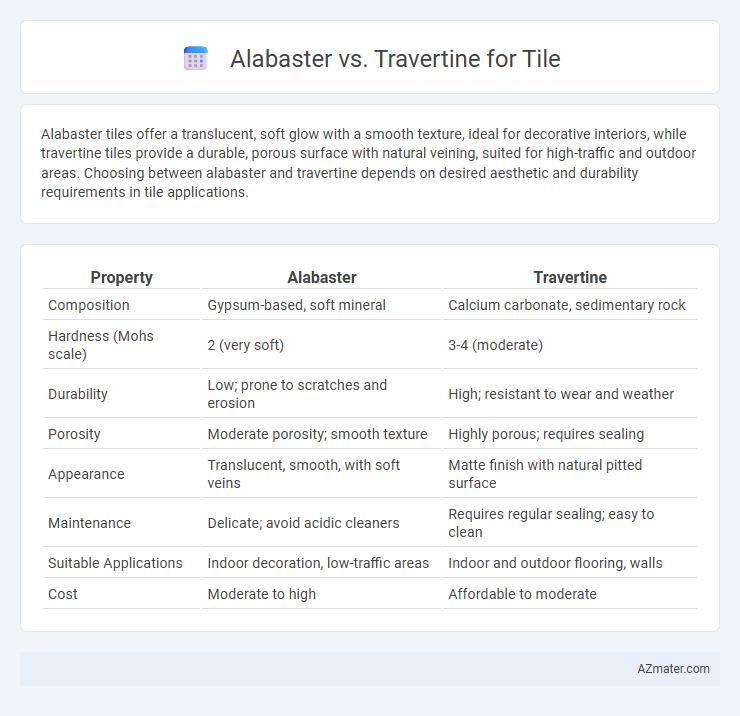Alabaster tiles offer a translucent, soft glow with a smooth texture, ideal for decorative interiors, while travertine tiles provide a durable, porous surface with natural veining, suited for high-traffic and outdoor areas. Choosing between alabaster and travertine depends on desired aesthetic and durability requirements in tile applications.
Table of Comparison
| Property | Alabaster | Travertine |
|---|---|---|
| Composition | Gypsum-based, soft mineral | Calcium carbonate, sedimentary rock |
| Hardness (Mohs scale) | 2 (very soft) | 3-4 (moderate) |
| Durability | Low; prone to scratches and erosion | High; resistant to wear and weather |
| Porosity | Moderate porosity; smooth texture | Highly porous; requires sealing |
| Appearance | Translucent, smooth, with soft veins | Matte finish with natural pitted surface |
| Maintenance | Delicate; avoid acidic cleaners | Requires regular sealing; easy to clean |
| Suitable Applications | Indoor decoration, low-traffic areas | Indoor and outdoor flooring, walls |
| Cost | Moderate to high | Affordable to moderate |
Introduction to Alabaster and Travertine Tiles
Alabaster tiles are prized for their translucent, smooth surface that allows light to softly diffuse, creating an elegant and warm ambiance in interior spaces. Travertine tiles feature a natural, porous texture with distinctive veining and earthy tones, offering durability and a classic aesthetic suitable for both indoor and outdoor applications. Both materials are sedimentary stones extensively used in flooring and wall cladding, with alabaster providing a delicate, luminous finish and travertine delivering rustic charm and robust performance.
Key Characteristics of Alabaster Tiles
Alabaster tiles are known for their smooth, translucent texture and soft, milky white appearance that adds elegance to interior designs. This material is softer and more porous than travertine, requiring careful sealing to prevent staining and damage. Its unique glow under light makes alabaster tiles a popular choice for creating sophisticated, ambient spaces.
Distinct Features of Travertine Tiles
Travertine tiles showcase unique porous textures with natural pits and troughs that create a rustic, earthy appeal, enhanced by their warm beige, cream, and rust color variations. Formed from mineral deposits of hot springs, travertine is highly durable yet requires sealing to prevent staining and moisture absorption. The stone's ability to develop a naturally honed or polished finish offers versatile options for flooring, walls, and backsplashes, making it a distinguished choice compared to smooth, uniformly white alabaster tiles.
Aesthetic Comparison: Alabaster vs Travertine
Alabaster offers a smooth, translucent appearance with soft, milky tones that create a luminous and elegant aesthetic, ideal for spaces aiming for a refined and delicate look. Travertine features a more textured surface with natural pitting and earthy hues ranging from beige to rust, providing a rustic, warm, and organic sensation in interior and exterior designs. The choice between alabaster and travertine tile hinges on whether a sleek, polished ambiance or a rugged, natural aesthetic is preferred for the project.
Durability and Longevity Differences
Alabaster tiles are softer and less durable than travertine, making them more prone to scratches and damage in high-traffic areas. Travertine, a dense and porous limestone, offers superior longevity and requires sealing to maintain its resistance to stains and wear. The enhanced durability of travertine makes it a preferred choice for flooring and wall tiles where long-term resilience is essential.
Maintenance Requirements
Alabaster tiles demand delicate maintenance due to their softness and susceptibility to scratches and acid etching, requiring gentle cleaning with pH-neutral cleaners and frequent sealing. Travertine tiles, while porous and prone to staining, benefit from regular sealing and basic cleaning routines that prevent dirt buildup and moisture damage. Choosing between Alabaster and Travertine depends on the willingness to commit to meticulous care versus moderately routine upkeep to preserve tile appearance and durability.
Cost Analysis: Alabaster vs Travertine
Alabaster tiles typically cost between $15 to $30 per square foot, reflecting their rarity and delicate nature, which requires careful handling and installation. Travertine offers a more budget-friendly option, averaging $3 to $7 per square foot, making it a popular choice for large-scale projects and flooring applications. Considering longevity and maintenance, Travertine generally incurs lower upkeep expenses, whereas Alabaster's higher initial cost is compounded by its susceptibility to scratching and staining.
Best Applications for Each Tile Type
Alabaster tiles excel in decorative indoor applications such as accent walls, backsplashes, and bathroom vanities due to their translucency and smooth, polished finish. Travertine tiles are ideal for both indoor and outdoor flooring, patios, and bathroom showers because of their durability, natural porous texture, and slip-resistant surface. Choosing alabaster enhances aesthetics in low-traffic areas, while travertine provides robust performance in high-traffic and moisture-prone environments.
Environmental Impact and Sustainability
Alabaster, a gypsum-based mineral, is less durable but requires less intensive mining compared to travertine, resulting in lower environmental disturbance during extraction. Travertine, a form of limestone, involves more energy-intensive quarrying and processing, contributing to higher carbon emissions and habitat disruption. Both materials can be sourced sustainably if obtained from certified quarries with responsible practices and used in eco-conscious design projects emphasizing longevity and minimal waste.
Choosing the Right Tile: Alabaster or Travertine
Alabaster tiles offer a smooth, translucent appearance with a soft, creamy white tone that enhances elegant, contemporary spaces, while travertine tiles provide a textured, earthy look with natural pitting and warm beige, cream, and brown hues suited for rustic or Mediterranean designs. Alabaster is softer and more prone to scratching, requiring careful sealing and maintenance, whereas travertine is durable and resilient but benefits from regular sealing to prevent staining. Choosing between alabaster and travertine depends on desired aesthetic, durability needs, maintenance willingness, and the tile location's exposure to wear and moisture.

Infographic: Alabaster vs Travertine for Tile
 azmater.com
azmater.com